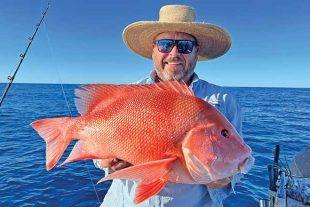In the past, the catch cry that you needed big lures or baits to catch big fish was popular among many anglers. This is fair enough but I have always worked on the principle that if you only use a big hook you will only catch big fish, but with a small hook you can catch big and small fish.
If you take this into consideration you are going to be playing the percentages and will end up with more fish and a wider variety of species at the end of the day. This philosophy is the trademark of how I choose my lures for the general running of my charter business, which guarantees both good numbers of fish as well as a variety of local species.
Catching numbers and variety is one thing but it doesn’t mean you won’t catch quality-sized fish too. My old cliché about my love of small lures for big fish, and many of my readers have heard this before, is: don’t elephants eat peanuts?
Let’s discuss some hard-bodied lures that have become the benchmark for my trade and most importantly the techniques for getting the best results from them. I do not carry a huge range of lures with me on a daily basis, even though I can’t resist the temptation to buy new lures to trial.
That tackle junkie is always going to be in me, as it is with most lure fishers, with the thinking being that the new lure might be the ultimate mouse trap. Apart from my mangrove jack lures, my main prerequisite is that most of my hard-bodies are under 60mm in length and dive to different depths.
The depths my lures cover range from surface, or topwater presentations as they are known, to deeper than 4m. I use 4m as a cut-off depth in this article because it is hard to find a small 55-60mm hard-body that will dive past the 4-4.5m mark. With my small surface lures for flathead, bream and whiting, I always try to fish over structured or bait-holding areas such as seagrass beds and yabby banks in water up to about 1.5m as a cut-off depth.
The exception to this cut off is when casting surface lures to jetties and submerged snags or when the opportunity arises to cast at visual surface activity that is usually created by pelagic species including tailor, trevally, queenfish and sometimes tarpon. When it comes to using diving hard-bodied lures, whether I decide to troll or cast them is determined by the depth of water I’m in. I choose to fish my lures to the depth they are designed to dive.
The result of matching the depth of water to the diving depth of the lure is the lure will skim and tap along the bottom, bringing up little puffs of sand, mud or whatever the bottom is. And trust me, fish such as flathead, bream and whiting cannot resist this technique.
Getting this action correct is vital in that it attracts the attention of predatory fish to begin with and it also looks like a small baitfish foraging along the bottom.
Something to remember if your lures are continually tapping the bottom is at some stage they might collect contaminants including weed, so you must keep the lure running clean at all times. Another point worth mentioning is while most lures have an advertised depth rating, in some cases they will dive a little deeper.
A couple of things that can contribute towards getting that bit of extra depth are using braid and leader that is very fine for its breaking strength, and lures always dive deeper when trolled or retrieved with the current rather than against the tidal flow.
If it helps with your initial choice of hard-bodied lures to get started with, my favourites are my own Little Mates, Pontoon21 CrackJacks, Atomic Hardz, Lively Lures Micro Mullets and OSP Dunks. All these lures swim hard and cover a range of diving depths.



However I can understand their bewilderment because many years ago when I first began trialling small blades I thought that each time I caught a jewie it was more good luck than good management. Well I know a lot better these days and my best jew captures in both numbers and size have come as a direct result of using small blades and soft plastics.
The soft plastics I use the most are 3” or less in size and my cut-off length for my most-used blades is nothing over 45mm. Once again, to get the best results with both these small lures it is important to choose the right time to use them and the correct technique, with a priority being that the lures be kept as close to the bottom as possible. Some of my favourite blades that might help you get started are Strike Pros, Damiki Vaults and TT Switchblades.
For soft plastics, I like Damikis, Z-Mans and Berkley Gulps. Small lures can be used at any time of the year but will be excellent through the winter months on the schools of migrating and spawning bream that are already making their presence felt.
Well thanks again and I’ll talk to you next month.
 Bush 'n Beach Fishing Magazine Location reports & tips for fishing, boating, camping, kayaking, 4WDing in Queensland and Northern NSW
Bush 'n Beach Fishing Magazine Location reports & tips for fishing, boating, camping, kayaking, 4WDing in Queensland and Northern NSW








